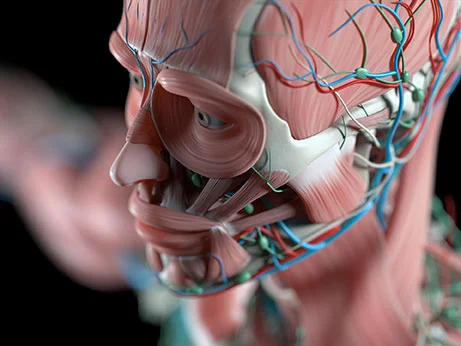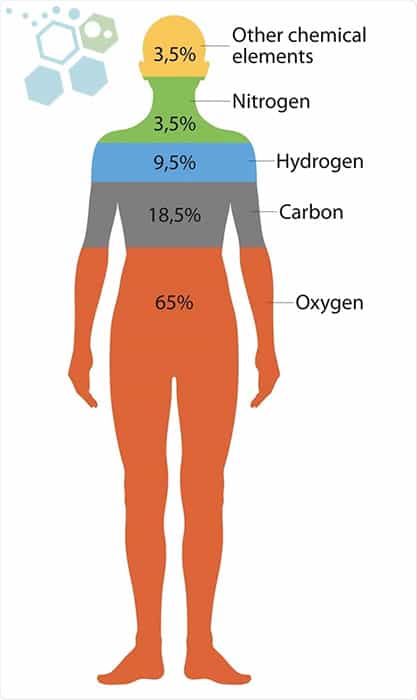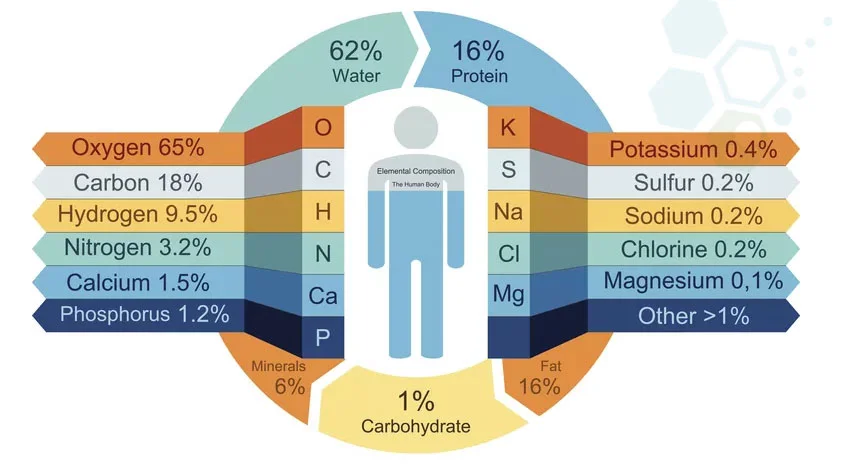Our body functions like a finely tuned well-oiled machine and is very intricate and remarkable. It takes many moving components to keep a person alive and well, and just 21 chemical elements drive every biological aspect of our bodies, from the common tasks to the spectacular.
Only 21 of the Earth’s 118 elements are present in a healthy human organism. DNA, cells, tissues, and organs are all made up of various molecules.
The following data is based on information provided by the International Commission on Radiological Protection (ICRP) and describes the elements and their relative abundances in the human body. Based on their concentrations in the human body, these 21 substances are divided into three groups: the four primary building blocks, the eight essential minerals, and the trace elements.
The Four Ingredients for Life
Only four elements are necessary for human survival.
- Oxygen
- Carbon
- Hydrogen
- Nitrogen
About 61% of a person’s total mass is made up of oxygen, making it the most prevalent element in the body. Water makes up between 60 and 70 per cent of the human body, which means that hydrogen and oxygen and are two of the most common chemical components. Together with carbon and nitrogen, these elements account for 96% of total body mass.
| Element | Weight of Body Mass (kg) | Percentage of Body Mass (%) |
| Oxygen | 43 kg | 61.3% |
| Carbon | 16 kg | 22.8% |
| Hydrogen | 7 kg | 10.01% |
| Nitrogen | 1.8 kg | 2.7% |
*Values are for an average human body weighing 80 kg
Let’s examine the roles played by these four chemicals in keeping our bodies running smoothly:
Carbon 
Due to its central role in our anatomy, carbon is sometimes referred to as the “basic building block” of all carbon-based living forms. You can’t have proteins, carbs, or healthy fats without it, and our primary energy source is the breakdown of carbohydrate and protein chains.
Hydrogen
Hydrogen, the element most often found in the universe, is present in all body fluids, facilitating the transfer and elimination of poisons and waste. Hydrogen helps keep our body’s joints lubricated and functioning properly. It has been suggested that hydrogen’s anti-inflammatory and antioxidant characteristics contribute to its ability to enhance musculoskeletal health especially in the hips, knees, shoulder and lower back.
Nitrogen
Nitrogen is integral to the amino acids used to construct peptides and proteins. The nucleic acids DNA and RNA, the molecular basis of our hereditary and genetic data, also include phosphate groups.
Oxygen
Metabolism, respiration, and the oxygenation of cells all rely on oxygen. Oxygen is also a component of all other major organic molecules in the body, such as those found in carbs, lipids, and nucleic acids. Everything in our bodies, from our cells and blood to our cerebrospinal fluid, contains it in significant amounts.
Other Essential Minerals
Getting enough of these “essential minerals” is crucial to maintaining good health. A good diet rich in minerals is essential for many bodily functions, including maintaining strong bones, healthy muscles, a healthy heart, and a fog free healthy brain. Minerals likewise regulate enzyme and hormone synthesis that is to our benefit. The growth and development of bones and the contraction of muscles both rely on the mineral calcium, a significant component of bone. Phosphorus is essential for energy metabolism, avoiding sports injuries, degenerative spinal discs, avoiding arthritis and vision loss.
The chemical makeup of some of the essential minerals is as follows:
| Element | Weight of Body Mass (kg) | Percentage of Body Mass (%) |
| Calcium | 1000 g | 1.42% |
| Phosphorus | 780 g | 1.12% |
| Potassium | 140 g | 0.22% |
| Sulphur | 140 g | 0.21% |
| Chlorine | 100 g | 0.13% |
| Sodium | 95 g | 0.14% |
| Magnesium | 19 g | 0.035% |
| Iron | 4.2 g | 0.01% |
*Values are for an average human body weighing 80 kg
 Thyroid and bone health and the electric transmissions that create nerve impulses and heart rhythms rely on the other macro-minerals, magnesium, potassium, iron, and sodium. An extreme lack of these minerals can lead to many health problems such as kidney disease, liver failure and autoimmune diseases. Vegetables, meat, legumes, and fruit are all excellent sources of these minerals, consumed by most of the human population regularly. However, these minerals might also be recommended as supplements if a deficiency is suspected.
Thyroid and bone health and the electric transmissions that create nerve impulses and heart rhythms rely on the other macro-minerals, magnesium, potassium, iron, and sodium. An extreme lack of these minerals can lead to many health problems such as kidney disease, liver failure and autoimmune diseases. Vegetables, meat, legumes, and fruit are all excellent sources of these minerals, consumed by most of the human population regularly. However, these minerals might also be recommended as supplements if a deficiency is suspected.
Trace Elements in Living Organisms
Minerals present in extremely minute quantities in biological tissues are known as “trace elements” or “trace metals.” Some of them are necessary for good nutrition, while others might not. When present, they contribute less than one per cent to body weight and often do so in small doses. Zinc, copper, manganese, and fluorine are some of the essential trace elements. Zinc is usually our first line of defense against infections, increasing resistance to illnesses, boost circulating stem cells and maintaining a healthy metabolic system. The human body is intricate and also amazing in simplicity. Our complex interconnected systems keep us alive but they all depend on just a handful of elements in nature. If we think about how truly complex the human body is, it feels magical.
Trace Elements
In our bodies, trace elements are distributed as follows:
| Element | Weight of Body Mass (kg) | Percentage of Body Mass (%) |
| Fluorine | 2600 mg | 0.00329% |
| Zinc | 2301 mg | 0.00329% |
| Copper | 72 mg | 0.00011% |
| Iodine | 13 mg | 0.000021% |
| Manganese | 12 mg | 0.00002% |
| Molybdenum | 9.5 mg | 0.000014% |
| Selenium | 8 mg | 0.00001% |
| Chromium | 6.6 mg | 0.00001% |
| Cobalt | 1.6 mg | 0.000002% |
*Values are for an average human body weighing 80 kg
Even though only it’s found in trace quantities, copper is instrumental in forming red blood cells and keeping nerve cells healthy. It also helps form collagen, a crucial part of bones and connective tissue. Even with constant research and studies to thoroughly understand these trace elements’ uses and benefits, scientists and researchers are constantly making discoveries. For example, recent research shows that senescence markers and these trace elements could be used to cure and fight chronic and debilitating diseases ranging from MND, ischemia to prostate cancer, heart disease, alzheimer’s, diabetes and hypertension.
Does Our Body Contain all the Known Elements?
Minor levels of substances with no established biological purpose can be found in the human body. Examples include:
- Germanium
- Lanthanum
- Niobium
- Antimony
- Tellurium
- Bismuth
- Thallium
- Silver
- Gold
- Other radioactive elements such as thorium, uranium, and radium.
However, the human body does not contain every element on the periodic chart, and these are mainly artificial chemicals and elements. Most superheavy nuclei have such short half-lives that they would instantly decay into one of the more common elements, making their occurrence in the body improbable.

